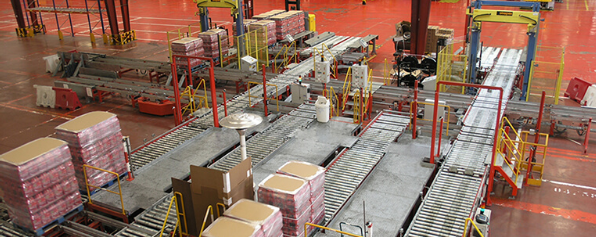In the dynamic world of modern manufacturing, automated material handling systems are the unsung conductors of efficiency. These systems silently ensure that raw materials, work-in-progress components, and finished products traverse the manufacturing floor with seamless precision.
Join us on a journey into the world of AMHS, where technology and precision converge to revolutionize how materials traverse the modern manufacturing landscape.

Table of Contents
What are the functions of Automated Material Handling Systems?
Here are the primary functions of automated material handling system:
Material Transport:
The core function of AMHS is to transport materials, products, or components from one location to another. This can involve moving items within a manufacturing facility, between different departments, or even between separate buildings.
Material Storage:
AMHS includes automated storage systems that enable the efficient and organized storage of materials. These systems can include Automated Storage and Retrieval Systems that use robotic mechanisms to retrieve items from storage racks.
Inventory Management:
AMHS helps in real-time tracking and management of inventory. It can monitor stock levels, automatically reorder materials when inventory is low, and provide accurate information for inventory control.
Sorting and Distribution:
AMHS can sort and distribute materials to their designated destinations. It is particularly useful in parcel distribution centers and warehouses where packages need to be sorted based on their destination.
Palletizing and Depalletizing:
AMHS systems are capable of automatically palletizing products or depalletizing them. This function is particularly important in industries where products are handled in bulk, such as in food and beverage or logistics.
Conveying:
Conveyor systems are a crucial part of automated material handling system, facilitating the movement of materials on conveyor belts. These systems are customizable and adaptable to different industries.
Order Fulfillment:
For e-commerce and distribution centers, AMHS plays a vital role in automating order fulfillment processes. It can efficiently pick and pack products for customer orders.
Quality Control:
AMHS systems can incorporate quality control checkpoints to inspect and verify the quality of products as they move through the production line.
Safety and Ergonomics:
AMHS helps improve workplace safety by reducing manual material handling, which can be physically taxing and lead to injuries. It also enhances ergonomics by minimizing repetitive and strenuous tasks.
Data and Reporting:
These systems gather data on material movement, inventory levels, and other key performance indicators. This data is used for analytics and reporting to optimize operations.
Integration with Other Systems:
AMHS integrates with other software systems such as Manufacturing Execution Systems, Enterprise Resource Planning systems, and Warehouse Management Systems to create a seamless flow of information and material.
Energy Efficiency:
Many AMHS systems are designed to be energy-efficient, helping reduce operational costs and environmental impact.
What are the benefits of automated material handling system?
Streamlined Operations:
These systems bring precision and predictability to material transport, reducing operational bottlenecks and enhancing overall workflow efficiency.
Material Traceability:
High-volume manufacturing demands meticulous material tracking. AMHS keeps a constant watchful eye on the location of every component or carrier, providing quick access to materials.
Labour Productivity:
By automating material transport, these systems liberate your workforce from manual handling responsibilities.
Cleanroom Compliance:
Reducing human movement through AMHS helps achieve and sustain these standards, ensuring that the final product meets stringent cleanliness requirements.
Safety and Compliance:
Beyond enhancing safety by reducing heavy lifting and manual material handling, automated material handling system also ensures compliance with regulations concerning weight limits for manual labour.
Quality Assurance:
Automated systems minimize the risk of handling errors, resulting in consistently high production quality. This is particularly crucial in industries where precision and consistency are paramount, such as automotive manufacturing or pharmaceutical production.
Space Utilization:
AMHS optimizes storage space, particularly vertical storage, making the most of the available facility space.
Energy Efficiency:
Many automated material handling system incorporate energy-efficient features, contributing not only to cost savings but also to a reduced environmental footprint. Energy-efficient motors, smart routing algorithms, and power-saving modes help in making manufacturing operations more sustainable.
Workplace Safety:
Reducing manual material handling significantly enhances workplace safety. The risk of injuries and accidents related to heavy lifting or material mishandling is minimized, creating a safer and more attractive work environment.
Data-Driven Insights:
AMHS generates a wealth of data about material movement and system performance. This data can be harnessed for analysis, leading to process optimization, cost reduction, and improved decision-making.
Minimized Downtime:
AMHS are known for their high reliability and minimal downtime. The systems are designed to operate continuously, reducing the chances of production halts due to material handling issues.
Scalable Solutions:
As production demands change and facilities evolve, AMHS can adapt to accommodate these variations. Whether it’s adjusting to new production volumes or reconfiguring layouts, these systems offer flexibility, future-proofing your operations.
What to look for before selecting a good AMHS service provider?
Industry Experience:
Ensure the provider has experience in your specific industry.
Customization:
Look for customization options tailored to your needs.
Scalability:
The system should grow with your business.
Reliability and Maintenance:
Check for minimal downtime and efficient maintenance.
Safety Compliance:
Verify adherence to safety standards.
Integration:
Seamless integration with existing systems is crucial.
Energy Efficiency:
Inquire about energy consumption and efficiency.
ROI Analysis:
The provider should assist in calculating ROI.
Training and Support:
Adequate operator training and technical support are essential.
References:
Review case studies and client references.
Data Analytics:
Look for data-driven insights and reporting.
Future-Proofing:
Ensure the system stays relevant with technology advancements.
Cost Transparency:
Transparent pricing and cost breakdowns are essential.
Comprehensive Service:
One-stop-shop for design, installation, and maintenance.
Customer Feedback:
Seek feedback from existing clients.
Local Support:
Consider local support for multi-location facilities.
Warranty:
Review warranty and service agreements.
Software Capabilities:
Assess the role of software in system efficiency and flexibility.
Summary –
The adoption of automated material handling system is revolutionizing manufacturing and warehouse operations across industries. These systems offer a multitude of benefits, including improved cycle times, efficient labour utilization, and enhanced material tracking. The reduction in contamination risk and adherence to regulatory standards further underline their significance.
In this transformative landscape, one name stands out: Godrej Koerber. With a rich legacy and a commitment to excellence, Godrej Koerber provides state-of-the-art AMHS solutions, ensuring reliability, scalability, and operational efficiency.
Elevate your material handling capabilities with Godrej Koerber and embrace the future of automation.
